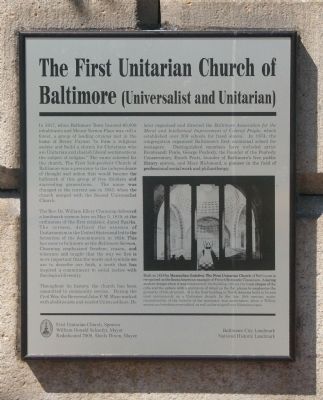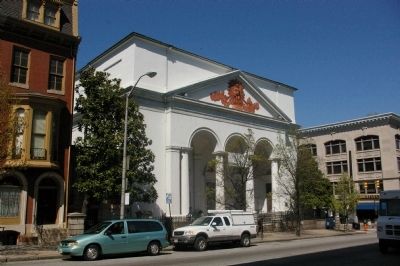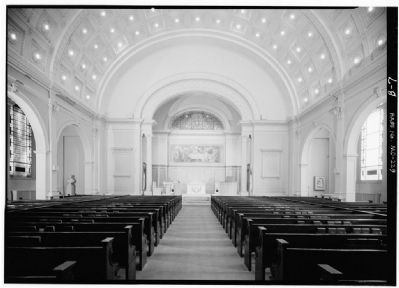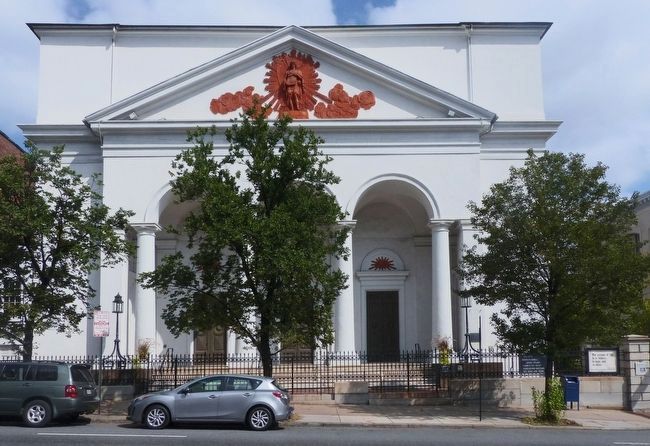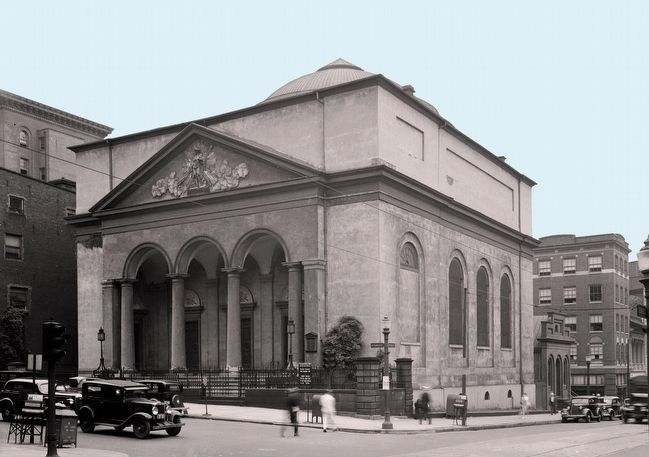Mount Vernon in Baltimore, Maryland — The American Northeast (Mid-Atlantic)
The First Unitarian Church of Baltimore
(Universalist and Unitarian)
Inscription.
In 1817, when Baltimore Town boasted 60,000 inhabitants and Mount Vernon Place was still a forest, a group of leading citizens met in the home of Henry Payson "to form a religious society and build a church for Christians who are Unitarian and cherish liberal sentiments on the subject of religion." The name selected for the church, The First Unitarian Church of Baltimore was a precursor to the independence of thought and action that would become the hallmark of this group of free thinkers and succeeding generations. The name was changed to the current one in 1935, when the church merged with the Second Universalist Church.
The Rev. Dr. William Ellery Channing delivered a landmark sermon here on May 5, 1819, at the ordination of the first minister, Jared Sparks. The sermon, defined the essence of Unitarianism in the United States and led to the formation of the denomination in 1824. This has come to be known as the Baltimore Sermon. Channing emphasized freedom, reason, and tolerance and taught that the way we live is more important than the words and symbols we use to describe our faith, a truth that has inspired a commitment to social justice with theological diversity.
Throughout its history, the church has been committed to community service. During the Civil War, the Reverend John F. W. Ware worked with abolitionists and tended to Union soldiers. He later organized and directed the Baltimore Association for the Moral and Intellectual Improvement of Colored People, which established over 200 schools for freed slaves. In 1874, the congregation organized Baltimore's first vocational school for teenagers. Distinguished members have included artist Rembrandt Peale, George Peabody, the founder of the Peabody Conservatory, Enoch Pratt, founder of Baltimore's free public library system, and Mary Richmond, a pioneer in the field of professional social work and philanthropy.
[photograph]
Built in 1818 by Maximilian Godefroy, The First Unitarian Church of Baltimore is recognized as the finest American example of French Romantic Classicism. A daring modern design when it was constructed, the building utilizes the basic shapes of the cube and the sphere with a minimum of detail on the flat planes to emphasize the geometry of the structure. It is the first building in North America built to be and used continuously as a Unitarian church. In the late 19th century, major reconstruction of the interior and sanctuary was undertaken, when a Tiffany mosaic and windows were added, as well as the magnificent Niemann organ.
Erected by the City of Baltimore, William Donald Schaefer, mayor, rededicated 2008, Shiela Dixon, mayor.
Topics and series.
This historical marker is listed in these topic lists: Abolition & Underground RR • Churches & Religion • Education • War, US Civil. In addition, it is included in the Maryland, Baltimore City historical markers, the National Historic Landmarks, and the Unitarian Universalism (UUism) series lists. A significant historical month for this entry is May 1767.
Location. 39° 17.712′ N, 76° 36.938′ W. Marker is in Baltimore, Maryland. It is in Mount Vernon. Marker is at the intersection of West Franklin Street (U.S. 40) and North Charles Street, on the right when traveling west on West Franklin Street. Touch for map. Marker is in this post office area: Baltimore MD 21201, United States of America. Touch for directions.
Other nearby markers. At least 8 other markers are within walking distance of this marker. A different marker also named The First Unitarian Church of Baltimore (here, next to this marker); Exercising Freedom: Overcoming Racial and Religious Boundaries (within shouting distance of this marker); Pope John Paul II Monument (within shouting distance of this marker); Expanding the American Intellect: Icons and Iconoclasts
(about 300 feet away, measured in a direct line); George Washington Bicentennial Marker (about 400 feet away); Basilica of the Assumption of the Blessed Virgin Mary (about 400 feet away); James Cardinal Gibbons Monument (about 400 feet away); The Basilica of the National Shrine of the Assumption of the Blessed Virgin Mary (about 400 feet away). Touch for a list and map of all markers in Baltimore.
More about this marker. This marker was installed in 2008 to replace a missing one that likely had similar text.
Also see . . . Photographs of the church from the Historic American Buildings Survey. (Submitted on September 19, 2015, by Allen C. Browne of Silver Spring, Maryland.)
Additional keywords. Unitarian Universalism
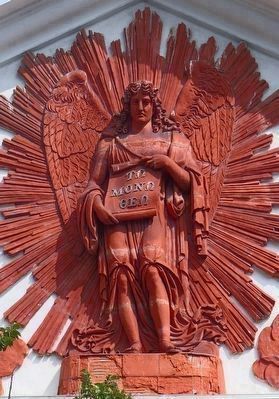
Photographed By Allen C. Browne, September 5, 2015
4. The Angel of Truth
Antonio Capellano made the original terra cotta relief “Angel of Truth” on the front of the church. The Greek inscription on the scroll (TΩ MONΩ θEΩ) translates “To the One God”. Noted Baltimore sculptor, Henry Berge (1908-1998), constructed a replica of the “Angel of Truth” in the late 1950s to replace the decayed original.

Photographed By Allen C. Browne, September 5, 2015
5. National Register Plaque
has been designated a
Registered Historic National
Historic Landmark
Under the provisions of the historic sites act of August 21,1935. This site possesses exceptional value in the commemorating or illustrating the history of the United States
National Park Service
1972
Credits. This page was last revised on April 17, 2020. It was originally submitted on April 16, 2008, by Christopher Busta-Peck of Shaker Heights, Ohio. This page has been viewed 3,007 times since then and 16 times this year. Photos: 1, 2. submitted on April 16, 2008, by Christopher Busta-Peck of Shaker Heights, Ohio. 3. submitted on May 15, 2008, by Christopher Busta-Peck of Shaker Heights, Ohio. 4, 5, 6, 7. submitted on September 19, 2015, by Allen C. Browne of Silver Spring, Maryland.
